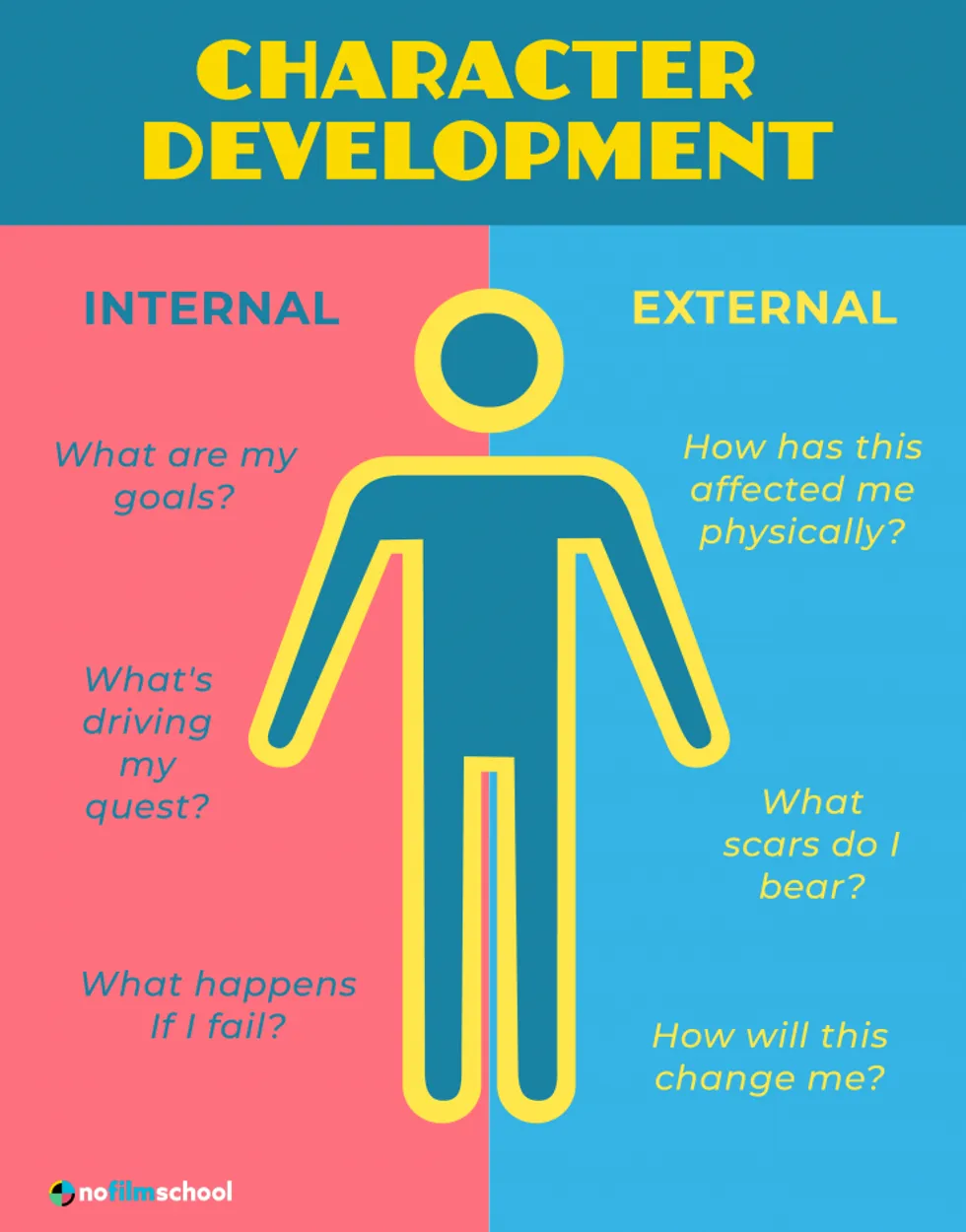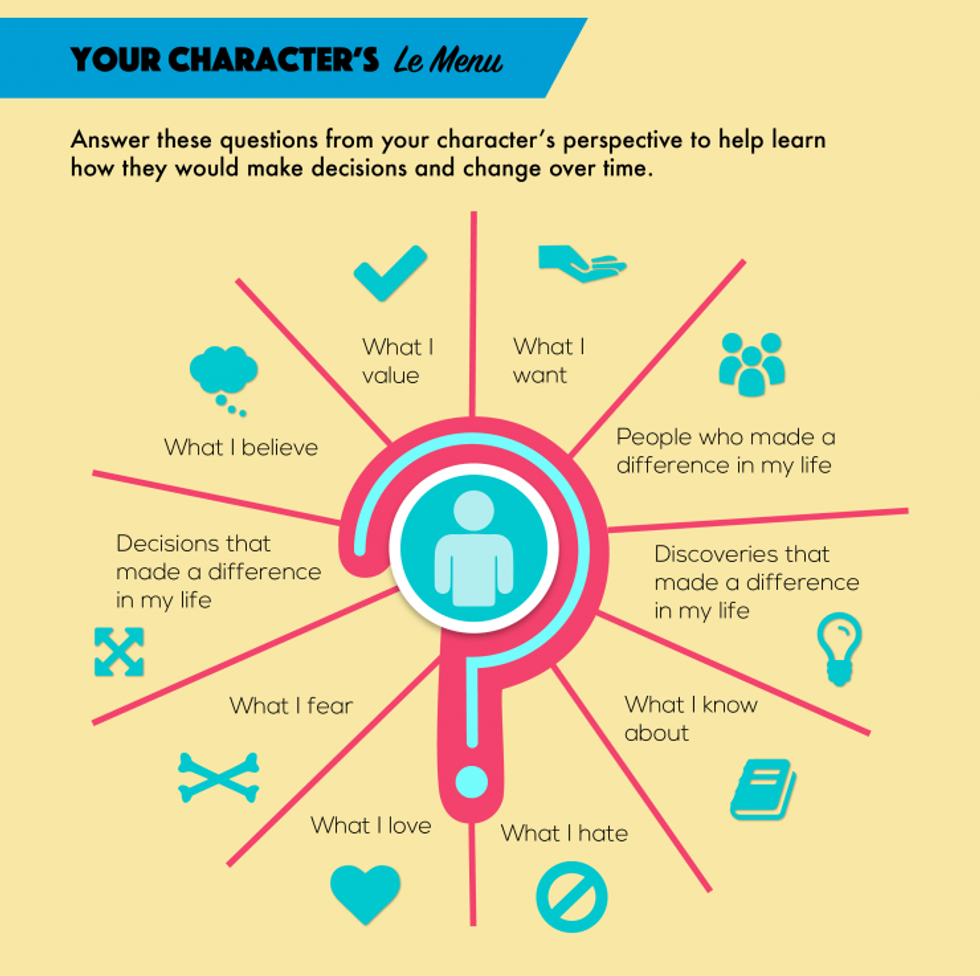
We’ve all sat down to watch our favorite TV show or movie series and enjoyed how the characters progress over time.
While these arcs are confined to different time frames or throughout multiple episodes, the core of a character is within their development. Character development is the foundation of every great and memorable character, and it’s something you have to master if you want to be a professional writer.
Characters matter. Whether you’re developing protagonists, antagonists, or minor characters, details about their lives and internal struggles matter.
Today we’ll go over the definition of character development, check out a free character development worksheet we made, and look at some examples from film and TV to help spark your storytelling journey.
Let’s go!
What is Character Development?
Character development is the process of creating a believable and realistic fictional character by giving them emotional depth. This does not matter if your character is human, an animal, or an anthropomorphized object (think Toy Story).
Character Development Definition in Two Parts
Character development comes in two parts: internal and external.
You can think of internal character development as your character’s fundamental goals and motivations for their actions. And external development as the struggles and scarring or transformative experiences that make them who they are on the outside.
Character Development Worksheet
When you’re trying to come up with a character or trying to continue their growth over the course of a story, it can be hard to track. So we enlisted our trusty graphic designer, April, to put together a character development worksheet for you. It should be a helpful reminder of interesting ways you can add to your character or just details that the audience can identify with as you move forward.

Let’s break down the character development worksheet and character development tips a little further.
Internal Character Development
As we mentioned in the definition, this tracks what’s going on inside your character. These statements would be found inside the person you are writing’s head. So let’s jump into them one by one and look at a few character development examples for each. A lot of these examples will mirror the goals we see in character arcs as well as internal and external conflict.
I wanted to give some character development tips under each heading, so we know where our heads are at when composing these, so you have some stuff to work on.
What are my goals?
This seems obvious, but your characters all need goals. Whether it’s Marlin finding Nemo, Elle Woods getting her degree, or Indiana Jones finding the ark, each person needs something they’re striving for, so they have direction.
What’s driving my quest?
There has to be a reason to get to the end of the road. For Marlin, it’s the fear that he will lose Nemo the way he lost his wife. For Elle, she wants to show her Ex that she’s smart and capable, and for Indiana Jones, it’s to stop the Nazis.
What happens If I fail?
This is where the stakes of your story get internalized. Sure, a character might just feel bad if they fail, but chances are there’s something more dire at play. Marlin will be left alone if Nemo is gone forever. Elle will never have self-worth, and a woman will wrongfully be in jail if she fails, and Nazis will have the most potent weapon in the world if Indiana can’t stop them.
External Character Development
When we’re digging into external character development, we want to know the physical changes these people go through as the story unfolds. Again, it could be throughout a few hours or the plan you have for the series.
How has this affected me physically?
This one is easy to nail down. What has the journey done to this person? Think about Gollum. When you’re developing a character like that you want to see the physical toll the ring has placed on him. The same goes for someone like Nick Fury. He’s a warrior who has seen a battle. Or what about Sarah Connor? She goes from party-girl waitress to hardened survivor.
Do I bear any scars?
This one is easy but important. Gollum is the shell of what a hobbit used to be. He’s a walking metaphor of gaunt evilness. Nick Fury has an eye patch that he got in a bad-ass way (no Captain Marvel spoilers!). It builds his mystique. Sarah Connor ends the first Terminator heading to Mexico with a bunch of weapons. In the second movie, she has physically changed. She’s rippled with muscle, and her demeanor is hardened and scary.
How will this change me?
As your character moves through the story, they’re going to have to be a little self-reflexive. It can help them deal with what’s going on internally and help them react externally. But there should be a fear of moving forward. An acknowledgment of the consequences to mental and physical being. Gollum knows what pain he’s in without the ring. Nick Fury is willing to die for the greater good – and in those movies, death is always on the table. Sarah Connor first fears for her own life, then the lives of billions on Judgement Day. She’s willing to die to end all this and to save her son’s life.
Internal and External Character Development in Television
We just hit a bunch of movie examples, but you need to develop characters for television. The fun thing is, over multiple seasons, these characters get to become different people. And before every season you and your writers’ room will decide how they grow. Let’s look at a few examples here.
How about Jim from The Office?
When we meet Jim, he’s comfortable slacking in his job. But over the next ten seasons, we meet a guy who starts being willing to take big chances. Externally, I love that he cleans up, tucks in, and we see him embrace wearing a Halloween costume. He does change, and its the development from who he was that makes that show special. And him and Pam developing/growing together sells the romance.
What about in a drama?
When you’re writing a pilot, your characters all start one way. You’re trying to convince people to follow along for an entire series. Chances are, you’re developing a character that will grow. Look at Peggy in Mad Men. In the pilot, she’s a mousey girl who’s unsure if she belongs in this world. Season to season, she rises through the ranks and also develops right in front of our eyes.
The development of Peggy happens throughout seven years, but you see it build episode to episode too. When you start a series, you need to know where these characters are going, and you need to set a foundation for growth.
Character Development Exercises
Writing can get dull. I like to try to switch things up or use practices we’ve dealt with before in other contexts to try to help in the process.
That’s why I loved our character development worksheet so much.
When you’re writing a film or TV show, you need to break a ton of characters and develop who they are within the story.
Let’s do a few exercises together to see how they work when developing characters.
The Character Map
Our incredible graphic designer, April, did a riff on our Story Map to make it into a Character Map.
This helps track where your character is in the plot. But ask yourself, “Where is my character at internally and externally during every plot beat?”
This may help you develop your character AND make each plot beat matter within your character arcs and development.

Check it out in list form:
-
Unraveling The Map – Introduce us to your characters in the beginning and show us who they start the screenplay as and what are their personality traits.
-
The Launch Point – Put your character in a situation where their shortcomings are evident. Show us how their problems will be exposed.
-
The First Leg – Put your character in situations where they learn to be different – ease them into it.
-
Change Course – Let your character embrace this new version of themselves and see how it can help them.
-
The Foot of the Mountain – What can the new and improved person accomplish?
-
Climbing The Side – As they go through the story show pushback on who they are versus who they used to be. Should they continue to change?
-
Through The Cave – Shed some light on the new person and how these new traits change the world.
-
Reassess the Problem – Is there a way for the new version of the character to confront old problems? Or will they revert to who they used to be?
-
Try and Fail – Let the arc put the character in new and terrible situations. Let them fail at things where they used to succeed.
-
The Fall – How does their new self completely ruin what they wanted? Did they go too far? What can they learn?
-
The Hidden Clue – What personal conclusion did their emotional journey lead to that they need to embrace now?
-
Race To the Finish – Now, as their fulfilled self, they can tie the plot up.
-
The Treasure Chest – Do they change?
-
Where We Go From Here – Keep your options open for how that person can continue to change in the future.
The Le Menu
Ah yes, the old Hellerman standy. At the beginning of “Crafting Short Screenplays that Connect” by Claudia Hunter Johnson, there is an exercise the writer refers to as “Le Menu.” It asks the reader to fill out a survey to figure out what kinds of stories they should write. Instead of filling out the Le Menu for yourself, I’d ask the writer to pretend to be the character and then write five to ten answers to:
- What I love
- What I hate
- What I fear
- What I believe
- What I value
- What I want
- What I know about
- People who made a difference in my life
- Discoveries that made a difference in my life
- Decisions that made a difference in my life

What’s Next? Develop Your Character’s Arc!
Well, I hope you and your understanding of character development has expanded. Now it’s time to take a look at our character arc post, so you combine them for a winning story. Also, take a look at our internal and external conflict post for ideas of the kinds of situations where we can see your characters develop.
And don’t forget about the six emotional arcs that you can use to help your screenwriting as well. These kinds of stories span film and television. It’s important to think about the types of changes and how they’ll carry over a movie, an episode, a season, and a series.
Got a great idea for a pilot or a feature? We have a Free Screenwriting Seminar and a Free Drama Pilot Seminar to help you get it out onto the page.
Like and share if this helped, and if you have questions, post them in the comments.
I can’t wait to read what you write next…
Author: Jason Hellerman
This article comes from No Film School and can be read on the original site.
